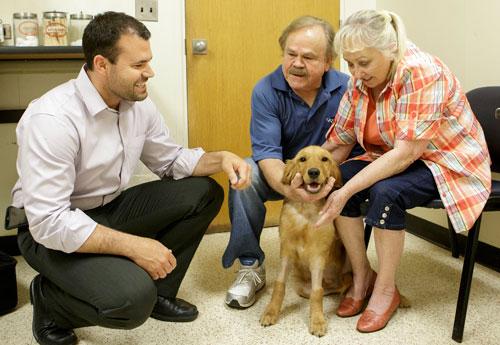
Do or Die: Veterinarians perform first-time procedure to save dog’s life
Tuesday, June 28, 2016
Pictured: Dr. Andrew Hanzlicek, Marley and Fred and Marcene Warford.
It was do or die – they would perform the procedure on six-month old Marley or he would die. The procedure had never been done before at Oklahoma State University’s Veterinary Medical Hospital but Marley’s owners, Marcene and Fred Warford of Muskogee, Okla., had faith the veterinarians would be able to help their golden retriever puppy.
“We noticed within the first week that something was wrong with Marley,” says Marcene. “He was vomiting, had diarrhea. He would go into stupors, just really zone out to where he didn’t even know where he was. It was frightening.”
“Marley came to OSU’s Veterinary Medical Hospital by way of a secondary referral from a referral hospital in Tulsa, Okla.,” explains Dr. Ryan Baumwart, veterinary cardiologist at OSU’s Veterinary Medical Hospital. “They found a shunt, a diversion of blood, in Marley’s liver that wasn’t operable by a traditional laparotomy, where they go in through the belly and try to put a constriction device on that. The shunt was inside of the liver so they gave us a call. They knew we had the equipment to do the procedure. Unfortunately, we had not done one to date here at OSU.”
“I just had a lot of confidence in what they were going to do,” says Marcene. “I felt real comfortable with the fact that I thought they could do it. This is where my vet, Dr. Lisa Jamison (’91), earned her degree. There was really no alternative because he would die without it.”
Baumwart and his colleague, Dr. Andrew Hanzlicek, a small animal internal medicine specialist, invited a professor from Purdue University to help out.
“With the expertise of Dr. Daniel Hogan, Dr. Hanzlicek and myself, we all went in
on the surgery and had a very good outcome,” states Baumwart. “We made a very small
incision in the neck to put a catheter in that allowed us to inject dye to outline
the abnormal blood vessel that we needed to try to decrease the amount of blood flow.
Once we did that, we were able to size a stent that went into the vena cava.
The stent held the device in place that we needed to put into the abnormal blood
vessel. We also had a plugging device outside of the stent. The idea was to decrease
the amount of blood flow through this vessel that was a shunt around the liver. The
liver is the detoxification center of the body and blood was actually getting bypassed
around the liver. So by closing this shunt, we can put blood back into the liver and
allow the dog to act more normally once the detoxification occurs in the blood. At
some point, we will have to go back in to try to close off that blood vessel even
more. We couldn’t completely occlude it because it would have caused too much pressure
inside of the liver. So we’re trying to slowly occlude that vessel.”
“This was the first time we have used OSU’s Veterinary Medical Hospital,” says Marcene. “It was fantastic. Everyone has been so congenial. They are marvelous. They kept me updated two or three times a day, which just made me very comfortable knowing he’s here, I could let go. I knew he was being taken care of.”
“Not only was this the first time we had done the procedure, it was a minimally invasive procedure,” adds Hanzlicek. “This dog, instead of having a big abdominal incision, had two very small incisions in his neck. We went through the vein and did the entire procedure. So the dog recovers more quickly and it is less painful. I think a lot of pet owners are looking for these types of procedures—minimally invasive—and we’re going to offer more and more of these here at Oklahoma State as time goes on and we learn more of these procedures.”
“Marley has a very good prognosis,” continues Hanzlicek. “Marley is expected to live a normal life after this procedure.”
“I would like to say thank you to Dr. Hogan at Purdue University for coming and donating his time and expertise,” concludes Baumwart. “He was very instrumental in making all of this work. He’s an excellent cardiologist and very generous with his time.”
“It took special pet owners in the Warfords to make this happen and a very kind and skillful cardiologist in Dr. Hogan,” adds Hanzlicek. “Thanks to all of them.”
